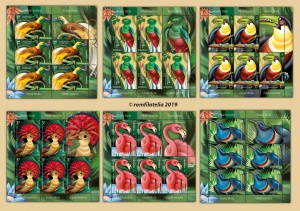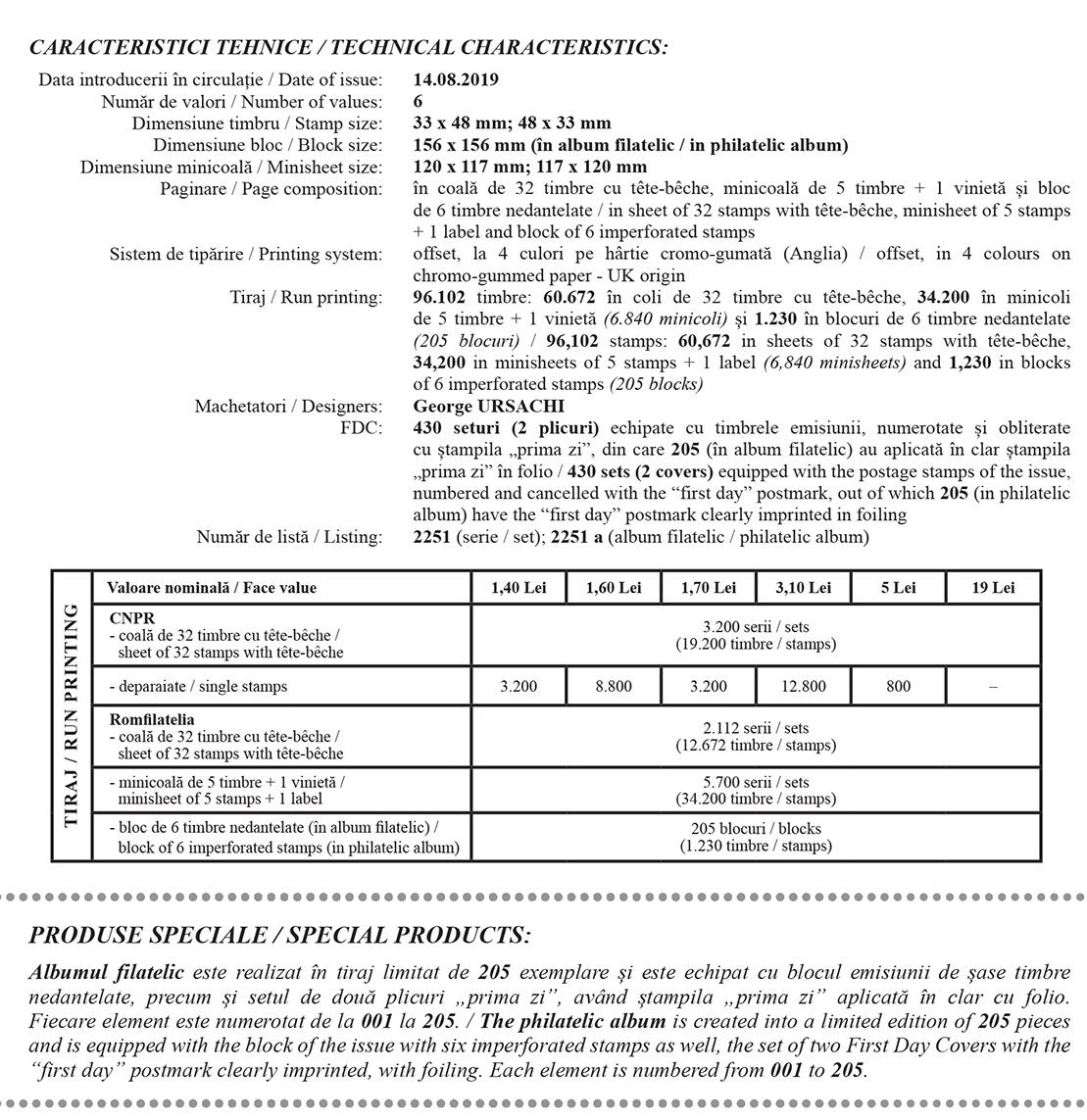Romfilatelia continues its series of projects dedicated to Fauna, one of the most appreciated topic by the collectors, by introducing into circulation the postage stamps issue entitled Exotic birds.
This philatelic issue, composed of six postage stamps and two First Day Covers, will be released into circulation Wednesday, August 14th, this year.
The Greater Bird-of-paradise – Paradisaea apoda, is illustrated on the postage stamp with the face value of Lei 1.40.
Measuring approximately 33cm, it is one of the most beautiful birds in the world and despite its shiny appearance it is hard to detect in a wooded terrain.
The birds-of-paradise are part of the Paradisaeidae family which comprises of over 50 species of birds characteristic to the regional wooded areas of Papua New Guinea, Maluku Islands and northern Australia. An original feature of these birds is the highly modified ornamental feathers. Sexual dimorphism is highly pronounced, females presenting with monochromatic dark plumage, while males plumage is bright and varied in colour, being considered the most beautiful birds in the world.
Their shrill call, which sounds like an echo in the forest is the element that betrays their position. They lower themselves on the branches of the crown voicing their call, in quick succession, around one call per second.
The males live in groups, separate from females, and gather around specific trees that they make use of during the mating ritual. The feed on what they find on tree trunks, molluscs, anthropoids and reptiles, but also fruits and seeds.
They nest in trees, with nests shaped like cups. The laying of the eggs generally results in two eggs of varied colouring.
Resplendent Quetzal – Pharomachrus mocinno, represented on the postage stamp with the face value of Lei 1.60, is part of the Trogonidae family and can be admired in areas of North and South America where it populates the forested areas at altitudes between 1200 m and 3000 m altitude.
The name “Quetzal” originates from the Aztec word “quezalli” which translates to “beautiful” or “precious”, this also being the reason that it has become an endangered species. The Quetzal has been admired for a long time, even as the national bird of Guatemala since the year 1871. Considered a symbol of the gods by Central American Aztecs, its feathers were only worn by tribal chiefs. The second largest city in Guatemala, after Ciudad de Guatemala is called Quetzaltenango (which translates to “place of the Quetzals”) which shows the appreciation towards this special bird. The bird attracts curious tourists and brings in significant tourist economy.
Considered one of the most spectacular birds in the world, the Quetzal inhabits the south of Mexico and Panama, easily recognisable due to its colourful plumage.
Their chest is a bright red colour that contrasts with its jade green plumage. The green and white dorsal feathers contrast with each other also.
They are easiest to observe during mating season, especially since the male goes through physical changes, growing long feathers (that can measure up to 1.40 m). These can reach lengths double to that of the body and end up covering their true tails. These new feathers are treasured and protected by the males who go as far as to change their flight patterns by choosing to gain momentum backwards, instead of the usual forwards soar that birds engage in, in order to not damage them.
The nesting period lasts from March until June. During the egg hatching period, the females sit in the nest facing the entrance and rest their plumes in a bent fashion. This period lasts from April until August, hatching two sets of eggs, often preferring to do so in a group with other birds in the holes found in rotting trees.
The green-billed toucan (Ramphastos dicolorus), or red-breasted toucan, illustrated on the postage stamp with the face value of Lei 1.70, belongs to the family Ramphastidae, living in southern and eastern Brazil, Pantanal of Bolivia, eastern Paraguay and far north-eastern Argentina. It is primarily found in the Atlantic Forest. Overall, it is fairly common, and therefore considered to be of least concern by IUCN (International Union for Conservation of Nature).
It is one of the smallest species of toucans, weighing 265 – 400 grams and measuring 40 – 46 cm long in total. Its beak is one of the shortest of toucans at only about 10 cm in length. Its breast is orange, with yellow at the sides. The beak is mostly pale greenish horn.
Toucans are monogamous, forming pairs for life. They are arboreal birds and nest in tree holes, the females laying 2 – 4 white eggs. The incubation period is 2-3 weeks. The chicks do not leave the nest for 2 months and only after this period begin to fly. The toucans are basically fruit-eating, but they also feed on insects and other small prey.
Northern Royal Flycatcher – Onychorhynchus mexicanus, depicted on the postage stamp with the face value of Lei 3.10, is part of the Tityridae family of birds. It measures approximately 18 cm and is easily recognisable by its distinctive crest feathers which are rarely exhibited outside the mating period. Its head and wings are brown with grey plumage on the sides of the head. Its neck plumage is white with its chest plumage of a grey colour, its ventral area is yellowish, and the tail is the colour of cinnamon with a dark tip. The spectacular aspect of this bird is its crest which lies folded on its head being semi-circular when unfolded and presents a distinctive red colour with blue markings.
Their call is especially spectacular, composed of a series of whistled notes.
It can be found in South-East of Mexico, North-West Peru, Bolivia, Venezuela and South-East Brazil. Its natural habitat comprises of subtropical or wet subtropical wooded environments.
The American Flamingo – Phoenicopterus ruber, whose image is reproduced on the postage stamp with the face value of Lei 5, is a gregarious freshwater and saline habitat bird that belongs to the Phoenicopteridae family. Measuring at 145 cm, the American flamingo is an easily identifiable bird due to its shiny plumage with red hues around the nape and its pale pink body, much like its beak that is tipped with black. Its wings contain black portions within the plumage. Its curved and narrow neck as well as its long and delicate legs were reproduced even in primitive cave paintings.
Its distinct colour is a result of its omnivorous diet, consisting predominantly of algae and small critters. Their method of eating is also special and unique as the flamingos move their head under water, making use of its long neck which permits the filtration of large quantities of water while swinging its unusual beak side-to-side. Because of their feeding habits, they are vulnerable to changes in habitat, such as pollution in the areas they inhabit.
Flamingos are all-season birds, forming immense and dense colonies during the mating period during which each couple defends the immediate territory around their nests. They are monogamous.
Nests are in the shape of a cone-base, and are built from mud and feature a slight depression on their top. They are laying eggs one time on season, especially one egg. Incubation is ensured by both genders during a 27-31 day period.
They inhabit the Caribbean Islands, Mexico, the northern coast of South America and the Galapagos Islands.
The magnificent riflebird − Ptiloris magnificus, illustrated on the last postage stamp of the series, with the face value of Lei 19, is a member of the Paradisaeidae from the Passeriformes order, being easily recognisable due to the colouring of its plumage. This bird measures up to 37 cm, males have dark colouring and short tailfeathers with long beaks and a blue iridescent area on their head and chest and females of the species have an elongated beak and are brown in colouring but display striped plumage on their ventral areas.
The distinctive parade of this species male entails puffing up the chest feathers and extending their wings, exposing themselves especially in tall trees and climbing vines.
The nest of these birds has a deep dome and is often built in a palm or similar tree.
They are spread in the area of New Guinea and Queensland, Australia, preferring forested areas, usually those at a higher altitude. Their nourishment comes from fruits and invertebrates.
Beautiful Hummingbird – Calothorax pulcher, depicted on the two First Day Covers of the issue, is part of the Trochilidae family, a large family comprising of over 400 species spread all over the New World alone. From Alaska until the Tierra del Fuego, from the ocean coast to the eternal snow of the mountains, mostly concentrated in the tropical climate of South America.
Known as one of the smallest birds on earth, the Beautiful Hummingbird measures on average 5cm. It’s easily recognisable due to the colourful plumage, males presenting with a golden-green dorsal area, with the black tail and wings, whitish ventral areas, tinged green on the flanks, and on their neck, they are collared with dark-pink feathers with violet markings.
Females don’t have a bright colour on their neck plumage, they have a light-yellow colour on their ventral areas and a pale grey stripe under their eyes, while their tail feathers are predominantly black, with a brown base and white tip.
Romfilatelia thanks the “Grigore Antipa” National Museum of Natural History from Bucharest for the documentary support given to this postage
stamps issue .




